Broadway (Los Angeles)
Broadway is a major thoroughfare in central Los Angeles and Los Angeles County, southern California. Broadway from 3rd to 9th streets in the Historic Core was the city's main commercial street from the 1910s until World War II. It is also the location of the Broadway Theater District, the first and largest historic theater district listed on the National Register of Historic Places (NRHP).[2] With twelve movie palaces located along a six-block stretch of Broadway, it is the only large concentration of movie palaces left in the United States.
Broadway Theater and Commercial District (NRHP) Broadway Theater and Entertainment District (City of Los Angeles) | |
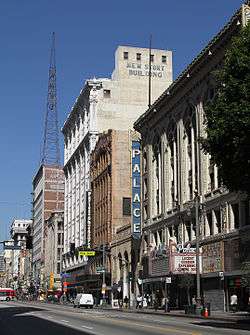 Broadway Theater District streetscape | |
 | |
| Location | 300—849 S. Broadway Los Angeles, California |
|---|---|
| Coordinates | 34°2′48″N 118°15′4″W |
| Architect | Multiple |
| Architectural style | Early Commercial, Late 19th And 20th Century Revivals, Art Deco |
| NRHP reference No. | 79000484 [1] |
| Added to NRHP | May 9, 1979 |
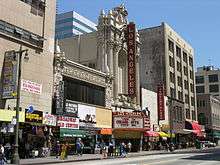 Broadway street view, with the Los Angeles Theatre at center, 2006 | |
| Maintained by |
|
|---|---|
| Length | 17.75 mi (28.57 km) |
| Location | Los Angeles |
| South end | Main Street near Gardena |
| Major junctions |
|
| Northeast end | Mission Road in Los Angeles |
| Construction | |
| Inauguration | 1890 |
Route
South Broadway's southern terminus is Main Street just north of the San Diego Freeway (I-405) in Carson. From there it runs 10 miles (16 km) north through Athens and South Los Angeles to Downtown Los Angeles – at Olympic Blvd. entering downtown's Historic Core, in which the buildings lining Broadway form the Broadway Theater District. Crossing 3rd Street, Broadway passes through the Civic Center including Grand Park. After crossing the Hollywood Fwy. (US 101), signs read "North Broadway" as it enters Chinatown. It then curves northeast, passing through old railyards, crosses the Golden State Fwy. (I-5) and heads due east to its terminus at Mission Road in Lincoln Heights.
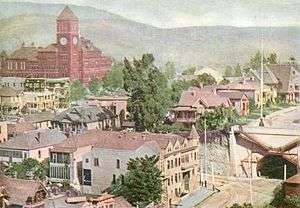
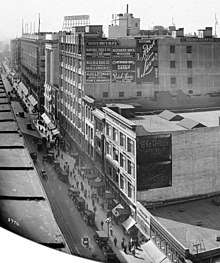
History
Founding and extension
Broadway is one of the oldest streets in the city, it was laid out as part of the 1849 plan of Los Angeles made by Lieutenant Edward Ord and named Fort Street. Fort Street began at the south side of Fort Moore Hill (a block north of Temple Street) at Sand Street (later California Street).
In 1890, the name of Fort Street, from 1st Street to 10th Street, was changed to Broadway. The rest of Fort Street, from California Street to 1st Street, was changed to North Broadway.[3][4]
Proposal for opening Broadway through to Buena Vista Street (now North Broadway), and extending the street south into what was then part of Main Street, below Tenth Street, in order to give a continuous, wide thoroughfare from the southern city limits to the Eastside, was made as early as February 1891.[5]
The Broadway Tunnel under Fort Moore Hill was opened in 1901, extending North Broadway to Buena Vista Street at Bellevue Avenue (later Sunset Boulevard, now Cesar Chavez Avenue). A section of Broadway in South Los Angeles was originally named Moneta Avenue until 1923.[6]
In 1909, construction on a bridge across the Los Angeles River was begun to connect Buena Vista Street to Downey Avenue, which ran from the river to Mission Road. The names of Buena Vista and Downey were then changed to North Broadway,[7][8][9] but not without significant objections from affected residents and landowners.[10][11][12][13] The bridge, which continued to be referred to as the Buena Vista Street Bridge for a good while, was opened to traffic in late September 1911.[14]
Los Angeles' central commercial and entertainment street
For more than 50 years, Broadway from 1st Street to Olympic Boulevard was the main commercial street of Los Angeles, and one of its premier theater and movie palace districts as well. It contains a vast number of historic buildings and is listed on the National Register of Historic Places.
Prior to the turn of the 20th century, the city's Central Business District was further north, along Spring and Main streets between the Plaza and 2nd Street. In 1895 J.W. Robinson's opened what was then considered a very large and impressive four-story department store at 239 S. Broadway,[15][16] signaling of the shift over the next decade and a half of the main shopping district to Broadway below 2nd Street.
Table of department stores on Broadway and 7th streets
| Opened | Closed | Store | Floor area (gross) | Location | Architects | Current use |
|---|---|---|---|---|---|---|
| 1893 | 1898 moved to 317 B’way | A. Fusenot Co. “Ville de Paris”[17] | Potomac Block: 221-3 Broadway | added to Coulter's late 1907, demolished 1958, now site of parking lot | ||
| 1895 | 1915 moved to 7th St. | Boston Dry Goods, later J.W. Robinsons | 239 S. Broadway (2nd/3rd) | Parking lot | ||
| 1896 | 1973 | The Broadway Dept. Store[18] | 1924, 577,000 sq ft (53,600 m2)[19] | SW corner 4th & Broadway, later through to Hill | Junipero Serra State Office Building | |
| 1898 | 1905/1917 moved | Coulter's (1898–1905),Ville de Paris (1905-1917) | 96,000 sq ft (8,900 m2)[20] | 317–325 S. Broadway through to 314–322 Hill Street[20] Homer Laughlin Building |
Grand Central Market | |
| 1899[21] | 1935-6 moved to 605 B'way[22][23] | Jacoby Bros. | 331-333-335 S. Broadway | Was "Boston Store" in late 1930s.[24] Currently independent retail. | ||
| 1899 | Myer Siegel | 251 S. Broadway (later 455 S. Broadway then 617 S. Broadway) | ||||
| 1904 | Silverwoods | 1920: 115,420 sq ft (10,723 m2)[25] | 556 S. Broadway (NE corner of 6th) | Broadway Jewelry Mart | ||
| 1905 | 1917 moved to 7th St. | Coulter's | 157,000 sq ft (14,600 m2)[26] | Potomac Block: 225-7-9 S. Broadway through to 224-6-8 S. Hill St. Late 1907 added 219-221-223 S. Broadway to store. | demolished, site of parking lot | |
| 1905 | 1917 moved to 7th St. | J. J. Haggarty Co. “New York Store’ | 337-9 S. Broadway | Independent retail. Only 2 stories remain. | ||
| 1905 | Fifth Street Store (Steele, Faris, & Walker Co.) | 1917: 278,640 sq ft (25,887 m2)[27] | SW corner 5th & Broadway | Replaced existing store with new building in 1917[27] | ||
| 1906 | Hamburger's, later May Company | 1906: 482,475 sq ft (44,823.4 m2)[28][29] 1930, >1,000,000 sq ft (93,000 m2)[30] |
SW corner 8th & Broadway by 1930, entire block 8th/9th/Broadway/Hill |
|||
| 1907 | 1983 | Bullock's | 1907: 350,000 sq ft (33,000 m2) 1934: 806,000 square feet (74,900 m2)[31] |
NW corner 7th & Broadway by 1934, most of the block 6th/7th/Broadway/Hill |
St. Vincents Jewelry Mart | |
| 1909 | J. M. Hale (Hale’s) | 341-343-345 S. Broadway[32] | retail, top floors were removed | |||
| 1910 | 1960s | Mullen & Bluett | 610 S. Broadway (Walter P. Story Bldg.)[33] |
Morgan, Walls & Clements | Mixed-use | |
| 1915 | 1993 | J. W. Robinson's | 1915: 400,000 sq ft (37,000 m2)[34] 1923: 623,700 sq ft (57,940 m2)[35] |
7th, Hope & Grand | Noonan & Richards (1915), Edgar Mayberry/Allison & Allison (1934 remodel) | Mixed-use |
| 1917 | 1933 | Ville de Paris, from 1919 B. H. Dyas | 420 W. 7th (SE corner Olive) | Dodd and Richards | L.A. Jewelry Mart | |
| 1917 | 1938 moved to Miracle Mile | Coulter's | 500 W. 7th (SW corner Olive) | Dodd and Richards | Mixed-use | |
| 1917 | Haggarty's | 7th & Grand[36][37][38][39] Brockman Building |
||||
| 1917 | became "The Famous" | Blackstone's | 118,800 sq ft (11,040 m2)[40] | 901 S. Broadway (SE corner 9th) | John Parkinson | Residential and ground floor retail |
| 1924 | 1972[41] | Desmond's | 85,000 sq ft (7,900 m2)[42] | 616 S. Broadway | A. C. Martin[43] | Renovated 2019 as office space, a restaurant and a rooftop bar.[42] |
| 1926 | 1984[44] | Barker Bros. | 23 acres (1,000,000 sq ft; 93,000 m2)[45] | 818 W. 7th (Flower to Figueroa) | Curlett and Beelman | Offices |
| 1930 | 1957[46] | Eastern Columbia | 1930: 275,650 square feet (25,609 m2)[47] (expanded through to Hill St. in 1950)[48] | 849 S. Broadway through to Hill | Claud Beelman | luxury condos |
| 1936[23] | 1938[49] | Jacoby Bros. | 605 S. Broadway[23] | became a branch of Zukor's (1940),[50] now mixed-use | ||
| 1947 | 1980[51] | Harris & Frank 2nd downtown location | 644 S. Broadway (Joseph E. Carr Bldg.) |
Robert Brown Young[52] | ||
| 1973 | open* | The Broadway | 250,000 square feet (23,000 m2)[53] | Broadway Plaza 750 W. 7th (Hope to Flower) | Charles Luckman | Macy's |
| 1986 | 1996 | Bullock's | Seventh Market Place now FIGat7th | Jon Jerde[54] | Gold's Gym (level M1), Target (M2), Zara (M3) | |
| 1986 | 2009a | May Company | Nordstrom Rack (level M1), Target (M2), H&M (M3) |
aas Macy's From around 1905 through the 1950s, Broadway was considered the center of the city, where residents went to ornate movie palaces and live theaters, and shopped at major department stores and shops.
The square footage of the four largest department stores alone — Bullock's at 806,000 sq ft (74,900 m2), The Broadway at 577,000 sq ft (53,600 m2)[55], May Co. at over 1,000,000 sq ft (93,000 m2)[56] and J. W. Robinson's (7th St. at Hope) at 623,700 sq ft (57,940 m2)[35][57] — totaled over three million square feet, the size of American Dream Meadowlands, America's largest mall today.
Among dozens of significant buildings from that era are the Bradbury Building, Ace Hotel Los Angeles, and the Los Angeles Examiner building designed by Julia Morgan.
Some of the movie theaters on the street fell into disuse and disrepair, some were replaced with parking lots, but many have been repurposed and/or restored. The department stores closed in the 1970s and 1980s, but Broadway has been the premier shopping destination for working class Latinos for decades.[58]
Theater District
NRHP refers to the district as the Broadway Theater and Commercial District, while the City of Los Angeles Planning Department refers to the Broadway Theater and Entertainment District.[59]
Highest concentration of movie palaces in the world
Stretching for six blocks from Third to Ninth Streets, the district includes 12 movie theaters built between 1910 and 1931. By 1931, the district had the highest concentration of cinemas in the world, with seating capacity for more than 15,000 patrons. Broadway was the hub of L.A.'s entertainment scene – a place where "screen goddesses and guys in fedoras rubbed elbows with Army nurses and aircraft pioneers."[60] In 2006, the Los Angeles Times wrote:
"There was a time, long ago, when the streets of downtown Los Angeles were awash in neon—thanks to a confluence of movie theaters the world had never seen before. Dozens of theaters screened Hollywood's latest fare, played host to star-studded premieres and were filled nightly with thousands of moviegoers. In those days, before World War II, downtown L.A. was the movie capital of the world."[61]
Columnist Jack Smith called it "the only large concentration of vintage movie theaters left in America."[62] Smith recalled growing up a mile from Broadway and spending his Saturdays in the theaters:
"I remember walking into those opulent interiors, surrounded by the glory of the Renaissance, or the age of Baroque, and spending two or three hours in the dream world of the movies. When I came out again the sky blazed; the heat bounced off the sidewalk, traffic sounds filled the street, I was back in the hard reality of the Depression.[62]
Because Broadway has been used as a filming location for decades, many of these theatre marquees can be seen in classic Hollywood films, including Safety Last! (1923), D.O.A. (1950), The Omega Man (1971), Blade Runner (1982), and The Artist (2011).[63][64]
Revitalization by Spanish-language cinema
In the years after World War II, the district began to decline, as first-run movie-goers shifted to the movie palaces in Hollywood, in Westwood Village, and later to suburban multiplexes. After World War II, as Anglo moviegoers moved to the suburbs, many of the Broadway movie palaces became venues for Spanish-language movies and variety shows. In 1988, the Los Angeles Times noted that, without the Hispanic community, "Broadway would be dead."[65] Jack Smith wrote that Broadway had been "rescued and revitalized" by "the Latino renaissance."[62]
Preservation and renovation efforts
The district has been the subject of preservation and restoration efforts since the 1980s. In 1987, the Los Angeles Conservancy started a program called "Last Remaining Seats" in which the old movie palaces were opened each summer to show classic Hollywood movies.[60][66] In 1994, the Conservancy's associate director, Gregg Davidson, noted: "When we started this, the naysayers said no one will go downtown to an old theater to see an old movie in the middle of the summer, but we get a number of people who have never seen a movie in a theater with a balcony. The older people (go) for nostalgia. And the movie people—seeing a classic film on a big screen is a different experience."[66] After attending a Conservancy screening, one writer noted: "The other night I went to the movies and was transported to a world of powdered wigs and hoop skirts, a rococo fantasy of gilded cherubs and crystal chandeliers. And then the film started."[60]
Despite preservation efforts, many of the theaters have been converted to other uses, including flea markets and churches. The Broadway movie palaces fell victim to a number of circumstances, including changing demographics and tastes, a downtown location that was perceived as dangerous at night, and high maintenance costs for aging facilities. With the closure of the State Theater in 1998, the Orpheum and the Palace were the only two still screening films.[67]
In 2006, the Los Angeles Times wrote: "Of all of L.A.'s many hidden gems, maybe none is as sparkling nor as hidden as the Broadway theater district downtown."[60] Bemoaning the possible loss of such gems, the same writer noted: "L.A. gave birth to the movies. To lose the astonishing nurseries where the medium grew up would be tragic."[60]
Broadway since 2008
In 2008, the City of Los Angeles launched a $40-million campaign to revitalize the Broadway district, known as the "Bringing Back Broadway" campaign. Some Latino merchants in the district expressed concern that the campaign was an effort to spread the largely Anglo gentrification taking hold in other parts of downtown to an area that has become the city's leading Latino shopping district.[68] A worker at one of the district's bridal shops noted, "On one side, I like the idea. The only thing is that I don't think they want our types of businesses."[68]
The Downtown's real estate revitalization, using the City's adaptive reuse ordinance that makes it easier for developers to convert outmoded and/or vacant office and commercial buildings into residential buildings, has reached the Broadway Historic District. It includes the transformation of the United Artists Theater office tower into the Ace Hotel Los Angeles, and restoration of its movie palace.
The Bringing Back Broadway commission is working on further reviving the landmark Los Angeles boulevard in the historic district. Led by City Councilman Jose Huizar, the commission has recommended widening sidewalks, eliminating traffic lanes, constructing new parking structures, and bringing back streetcar service reminiscent of the street's past.[69] A pedestrian-friendly project finished up in December 2014 that widened the sidewalks and replaced the parking lane with planters, chairs and round cafe tables with bright-red umbrellas. The Great Streets Initiative seeks to bolster the street-level health of the city by making several dozen boulevards more hospitable to pedestrians, cyclists and small businesses. Mayor Eric Garcetti said the effort represents "a shift from the way that our neighborhoods have been planned in Los Angeles," with a new focus on "walkability and transit."[70]
Broadway retail is transitioning from a broad mix of stores catering to Hispanic immigrants and a burgeoning sneaker and streetwear retail cluster has emerged from 4th to 9th streets: Sneaker Row.[71]
Retail in and around the Eastern Columbia, located at the intersection of 9th Street & Broadway, has proliferated in recent years with the opening of Acne Studios, Oak NYC, Aesop, Tanner Goods, BNKR, Austere, A.P.C., and Urban Outfitters located in the Rialto Theater (Los Angeles Historic-Cultural Monument No. 472).[72][73]
List of theaters, other landmark buildings and sites
All landmarks in geographic order, north to south:
| West side | East side |
|---|---|
| Chinatown | |
|
| |
|
|
| Hollywood Freeway to Temple Entering Civic Center (site of Central Business District, 1880s-1890s) | |
* L. A. County Hall of Justice (1925)
| |
| TEMPLE ST. part of Civic Center (site of Central Business District, 1880s-1890s) | |
|
West side:
|
East side:
|
|
FIRST ST. | |
West side:
|
East side:
|
|
SECOND ST. | |
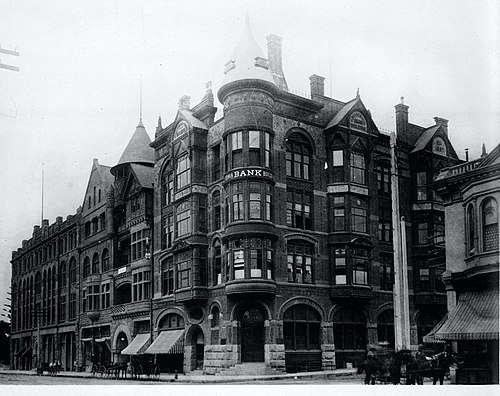 California Bank Building SW corner 2nd and Broadway Los Angeles around 1890 West side:
 Boston Dry Goods (237-241) and Harris Newmark (231-5) buildings, Broadway, Los Angeles, 1899
|
East side:
|
| Entering Historic Core | |
|
THIRD STREET | |
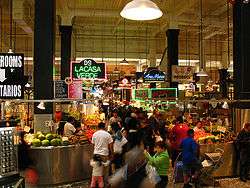 Grand Central Market, once home to the Ville de Paris and B. H. Dyas department stores West side:
|
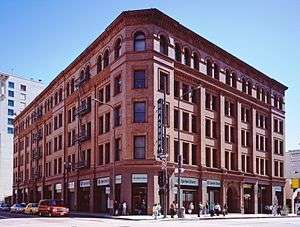 Bradbury Building, built in 1893 East side:
|
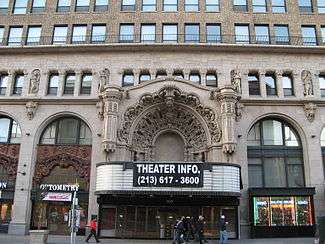 Million Dollar Theater
| |
|
FOURTH ST. | |
.jpg) Terrazzo floor of former Newberry's five and dime West side:
|
East side:
|
|
FIFTH ST. | |
|
West side:
|
 Broadway Arcade building, 2014 East side:
|
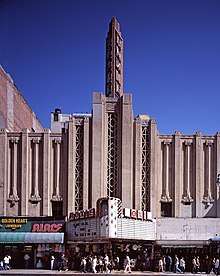 Roxie Theatre
| |
| |
| |
|
SIXTH ST. | |
|
West side:
|
East side:
|
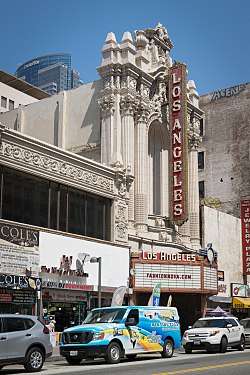 Los Angeles Theatre
| |
.jpg) Palace Theater
| |
|
SEVENTH ST. | |
 Reich and Lièvre store at 737-745 S. Broadway depicted in 1917 ad for store opening West side:
|
 Hotel Lankershim (demolished) East side:
|
.jpg) State Theater
| |
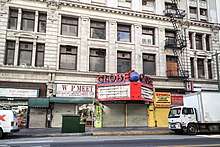 Globe Theater
| |
|
EIGHTH ST. | |
|
West side:
|
East side:
|
 Tower Theatre
| |
Rialto Theater
| |
Orpheum Theatre marquee
| |
| NINTH ST. | |
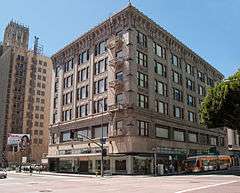 Blackstone's Department Store building West side:
|
|
| |
| OLYMPIC BLVD. (ORIG. TENTH STREET) | |
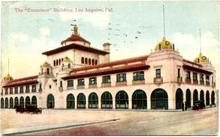 Los Angeles Examiner Bldg.
| |
Other surviving theaters adjacent to Broadway
- Warner Bros. Downtown Theatre – Vaudeville theater and movie palace – Located at 401 W. 7th St (northwest corner of South Hill and West 7th St). Opening on August 17, 1920, it was originally called the Pantages Theatre, but was renamed Warner Bros. Downtown Theatre in 1930 after the Hollywood Pantages Theatre was opened.[98][99] The exterior has an imposing domed corner tower, flanked by twin facades on 7th and Hill.[100] Later in the 1960s, it was known as the Warrens Theatre.[99] It currently houses a jewelry store.
- Olympic Theatre – Movie palace – Located at 313 W. 8th St, half a block from S. Broadway, it originally opened in 1927 as Bard's 8th Street Theatre, converted from a restaurant. For a time, it had a second entrance on Broadway. After a period as a chandelier store, COS, a higher-end brand of H&M, began remodeling the store in 2016.[101][95]
- Mayan Theater – Vaudeville theater and movie palace – Located at 1014 South Hill Street. Opened in August 1927 and now designated a Historic Cultural Monument, the Mayan is currently used as a nightclub. Current capacity: 1,491
- Belasco Theatre – Legitimate theater – Located at 1050 South Hill Street, adjacent to the Mayan. Built by the Belasco brothers, and designed by Morgan, Walls and Clements. It served as a church from 1950 to 1987, renovations were completed in 2011 to modernize the sound and lighting systems.[102] Currently hosts services for the Los Angeles campus of Hillsong Church. Current capacity: 1,601.
Public transportation
LA Metro's Historic Broadway station is an under-construction underground light rail station near the intersection of 2nd and Broadway,[103][104] part of the new Regional Connector tunnel extending light rail lines that currently terminate at 7th Street/Metro Center station, to Union Station. In the new scheme that LA Metro will adopt when the Connector opens, trains will run from Historic Broadway Station on the "E" line east to East Los Angeles and west to Santa Monica, and on the "A" line northeast to Union Station, Pasadena, and Azusa and south to Long Beach.[105]
Metro Silver Line bus rapid transit (BRT) has 5 stations adjacent to Broadway in South Los Angeles: 37th Street/USC, Slauson, Manchester/I-110, Harbor Freeway, and Rosecrans. These stations are along the Harbor Transitway, a dedicated busway between Downtown L.A. (Adams Blvd.) and the Harbor Gateway, near Carson, in the median of the Harbor Freeway (I-110), just west of Broadway. Silver Line BRT runs as far south as San Pedro and as far northeast as El Monte.
Metro Local bus line 45 serves most of the length of Broadway, between Lincoln Heights through Downtown to El Segundo Blvd. in Athens. Metro Rapid line 745 serves Broadway from Cesar Chavez Avenue downtown to Imperial Highway in South L.A. Local routes 2, 4, 30, 33 and 40 serve portions of Broadway downtown.
See also
References
- "National Register Information System". National Register of Historic Places. National Park Service. April 15, 2008.
- Sandra A.B. Levis. "Broadway Historic Theater District: A walking tour sponsored by the Los Angeles Conservancy" (PDF). Los Angeles Conservancy.
- "City In Brief". Los Angeles Times. September 6, 1889. p. 8. Alternate Link via ProQuest.
- "No Title". Los Angeles Times. February 18, 1890. p. 4. Alternate Link via ProQuest.
- "Sou', Sou'west". Los Angeles Times. February 26, 1891. p. 4. Alternate Link via ProQuest.
- "Realtors Want New Boulevard: Ask Supervisors for Route Connecting Moneta Avenue With Harbor". Los Angeles Times. December 10, 1922. p. V9. Alternate Link via ProQuest.
- "A Literary Fog". Los Angeles Times. November 30, 1909. p. II4. Alternate Link via ProQuest.
- "The Lancer". Los Angeles Times. January 22, 1911. p. II5. Alternate Link via ProQuest.
- "Downey And Buena Vista Will Be North Broadway". Los Angeles Herald. 35 (353). September 19, 1908 – via California Digital Newspaper Collection.
- "Object to Changing Name". Los Angeles Herald. 32 (105). January 14, 1905 – via California Digital Newspaper Collection.
- "Buena Vista Street Will Continue Name: Will Not Be Changed to North Broadway". Los Angeles Herald. 32 (238). May 27, 1905 – via California Digital Newspaper Collection.
- "Object to Merger Of Downey Avenue". Los Angeles Herald. 36 (24). October 25, 1908 – via California Digital Newspaper Collection.
- "East Side Residents, Prefer Downey Avenue". Los Angeles Herald. 37 (200). April 19, 1910 – via California Digital Newspaper Collection.
- "Majestic; Great Viaduct About Ready; Cars Run Over the Buena Vista Structure; Concrete Bridge Across Los Angeles River Weighs Nearly Forty Thousand Tons, Cost Two Hundred and Seventy-five Thousand Dollars—Without a Peer in West". Los Angeles Times. September 24, 1911. p. II1. Alternate Link via ProQuest.
- "The Boston Dry Goods Store". Los Angeles Times. January 1, 1895. p. 29. Retrieved May 3, 2019.
- "The New Boston Store:Los Angeles' Finest Commercial Structure Is Complete". Los Angeles Herald. October 4, 1895. p. 5.
- "Ville de Paris 1901". Calisphere, University of California Library. Archived from the original on September 9, 2018. Retrieved September 9, 2018.
- https://cdnc.ucr.edu/cgi-bin/cdnc?a=d&d=LAH18950804.2.28&e=-------en--20--1--txt-txIN--------1
- "Framework is now finished: Construction Started Late Last Fall: Additional Will Be Completed During July: Department Store Growth Is Consistent". Los Angeles Times. March 23, 1924. p. 91. Retrieved May 26, 2020.
- "Advertisement for Ville de Paris". Los Angeles Herald. August 15, 1907. Retrieved May 17, 2019.
- "Los Angeles Herald 22 August 1899 — California Digital Newspaper Collection". cdnc.ucr.edu.
- "Advertisement for Jacoby Bros./May Co". Los Angeles Times. May 19, 1935.
- "Pioneers' Modern Home: Jacoby Bros.Will Open New Store Soon". Los Angeles Times. January 31, 1936. p. 11.
- https://www.newspapers.com/clip/56348763/boston-store-los-angeles-1939-331-s/
- "Magnificent Pile That Now Graces Broadway Corner". Los Angeles Times. August 31, 1920. p. 9.
- "Great Store for Coulter". Los Angeles Times. August 2, 1904. p. 13.
- "Broadway Buildings: To Cost Million". Los Angeles Times. April 22, 1917. p. part V p. 13.
Eight stories…plus basement and sub-basement…172 feet on Broadway by 162 feet on Fifth
- "Great Store's First Drill: Hamburger Army Through Paces for Opening; Get Familiar With "Lay" of New Establishment; Many Delights for Shoppers Are in Prospect". Los Angeles Times. July 26, 1908. p. V13. Alternate Link via ProQuest.
- "Hamburger's Big Store Celebrates: Thirty-Fifth Anniversary Sale To Mark Event; Started in Small Room on Main Street, Now Occupies Building with Thirteen Acres of Floor Space---History of the Great Emporium's Growth and Success". Los Angeles Times. October 29, 1916. p. III_A15. Alternate Link(subscription required) via ProQuest.
- "Advertisement for May Company". Los Angeles Times. March 25, 1930. p. 10.
- "Bullock's Department Store #1, Downtown, Los Angeles, CA (1906-1907)", PCAD
- "Moving to Broadway: J. M. Hale Co. Go to Petticoat Lane". Los Angeles Evening Express. January 23, 1909. p. 4.
- "Walter P. Story Building". Los Angeles Conservancy. Retrieved August 9, 2020.
- "Steam Shovels Scooping Out Dirt At Site Of Big Store", Los Angeles Times, May 24, 1914
- "Department Store Addition Now Rising Into Space", Los Angeles Times, 11 January 1923
- "J.J. Haggarty Growth Laid to Enterprise". Los Angeles Times. November 10, 1940. p. 67 (Part IV Society, p.9).
- Auerbach, Alexander (May 27, 1970). "J.J. Haggarty Dress Chain Forced Out of Business by Debt". Los Angeles Times. p. 56 (part III Business & Finance, p.1). Retrieved April 23, 2019.
- "New York Store's Life Dream Comes True: J. J. Haggarty Ready to Open New Emporium at Seventh and Grand Tomorrow". Los Angeles Evening Express. September 19, 1917.
- "The "New York" to Start Building". Los Angeles Times. November 19, 1916. p. 27.
- "Material Progress: Millions Going into Broadway Buildings: New Blackstones". Los Angeles Times. April 22, 1917.
90 feet of frontage on Broadway and 165 feet on 9th Street…with 6 stories plus two basement levels
- "Ad for Desmond's Downtown LA Removal Sale". Los Angeles Times. February 10, 1972. p. 7.
- Vincent, Roger. "Historic home of clothier Desmond's is ready for its comeback on Broadway". latimes.com. Retrieved on 16 April 2019.
- Gray, Olive (September 16, 1924). "New Desmond Store Opened". Los Angeles Times.
- "Ad for Barker Bros". Los Angeles Times. September 24, 1984. p. 6.
- Whitaker, Alma (July 13, 1931). "Furniture Has Its Romance: Fascinating Tale Found in Barker Brothers: Enormous Business Started by Outraged Man: Fourth Generation Working at Present Time". Los Angeles Times. p. 23. Retrieved May 19, 2019.
- https://www.newspapers.com/clip/31500749/easterncolumbia_closes_down_1957/
- "Concern Occupies New Home Tomorrow". Los Angeles Times. September 11, 1930. p. 8.
- https://www.newspapers.com/clip/31499801/easterncolumbia_expansion_1950/
- "Advertisement for liquidation of Jacoby Bros". Los Angeles Times. September 30, 1938. p. 45.
- "Downtown Broadway Store Leased in $1,000,000 Deal: Business Prepares to Expend $150,000 in Converting Property to Its Uses". Los Angeles Times. February 11, 1940. p. 63.
- "Harris & Frank advertisement". Los Angeles Times. January 17, 1980. Retrieved May 7, 2019.
- "Los Angeles Union Station Run-through Tracks Project", p. RA6-PP8
- "Broadway Plaza", Pacific Coast Architecture Database
- https://www.latimes.com/archives/la-xpm-1986-04-06-re-24817-story.html
- "Framework is now finished: Construction Started Late Last Fall: Additional Will Be Completed During July: Department Store Growth Is Consistent". Los Angeles Times. March 23, 1924. p. 91. Retrieved May 26, 2020.
- https://www.newspapers.com/clip/39054539/los-angeles-herald/
- pcad.lib.washington.edu/building/9453/
- DiMassa, Cara & Bloomekatz, Ari B. (January 28, 2008). "L.A. plans Broadway face-lift". Los Angeles Times. pp. B1, B8.
- Broadway Theater and Entertainment District Design Guide, City of Los Angeles Planning Department, 2009
- Dan Turner (June 11, 2006). "Our So-Cal Life: Faded glory on Broadway". Los Angeles Times.
- Cara Mia DiMassa (February 17, 2006). "Movie Tradition Fading to Black; Seventy years after its neon heyday, downtown Los Angeles is struggling to keep its last cinematic venue afloat". Los Angeles Times.
- Jack Smith (September 30, 1986). "Los Angeles Theater: Flashback to yesteryear ... and a Latino renaissance on Broadway". Los Angeles Times.
- Filming locations for "D.O.A." (1950) at IMDb
- Filming locations for "The Omega Man" (1971) at IMDb
- Dan Sullivan (August 21, 1988). "L.A.'s Grand Old Broadway Theaters". Los Angeles Times.
- Robert Levine (June 12, 1994). "Silent Screens: Encore for Carter, Old Movie District". Los Angeles Times.
- John Regardie (November 2, 1998). "State of Darkness: Another Movie Palace Quits Screening Films". Los Angeles Downtown News.
- Cara DiMassa (January 28, 2008). "L.A. plans Broadway face-lift". Los Angeles Times.
- "Bringing Back Broadway". City of Los Angeles.
- Hawthorne, Christopher (December 6, 2014). "'Latino Urbanism' influences a Los Angeles in flux". Los Angeles Times.
- https://www.latimes.com/business/la-fi-sneaker-row-20181208-story.html
- Jose Huizar - Councilmember District 14, City of Los Angeles. "Councilmember Huizar's Bringing Back Broadway Initiative Welcomes Acne Retail" (PDF). Archived from the original (PDF) on September 23, 2015. Retrieved May 18, 2019.
- Fashionista. Inside Downtown Los Angeles's Retail Boom
- https://www.newspapers.com/clip/31677707/coulters_location_1906_225229_s/
- "Ad for Coulter's new store opening". Los Angeles Times. May 31, 1905.
- https://www.newspapers.com/clip/57352206/western-shoe-company-western/
- "The Boston Dry Goods Store". Los Angeles Times. January 1, 1895. p. 29. Retrieved May 3, 2019.
- "The New Boston Store:Los Angeles' Finest Commercial Structure Is Complete". Los Angeles Herald. October 4, 1895. p. 5.
- "CityDig: This Was L.A.'s City Hall for 39 Years". Los Angeles Magazine. May 8, 2014. Retrieved May 16, 2019.
- "Jacoby Bros. ad". Los Angeles Times. November 28, 1899. Retrieved May 22, 2019.
- https://cdnc.ucr.edu/?a=d&d=LAH19210307&e=-------en--20--1--txt-txIN--------1
- https://www.loopnet.com/Listing/318-320-S-Broadway-Los-Angeles-CA/14182481/
- Kathleen Craughwell (May 26, 1996). "Movies: Broadway West; Bringing the Classics Back Home". Los Angeles Times.
- "About the Broadway Theatre Group". Retrieved August 16, 2015.
- "State Theatre and Building | Los Angeles Conservancy". www.laconservancy.org. Retrieved July 26, 2017.
- Samudio, Jeffrey; Lee, Portia (2001). Images of America: Los Angeles, California (trade paperback). Chicago, IL: Arcadia Publishing. p. 106. ISBN 0-7385-0812-8.
- http://www.statetheatre.la
- Pool, Bob (January 25, 2014). "Checking out Broadway's old theaters of the superb". Los Angeles Times. Retrieved June 30, 2014.
- Pennacchio, George (June 25, 2014). "Globe Theatre Marquee on Broadway Relit". KABC-TV. Retrieved June 30, 2014.
- "Ninth and Broadway Building", Los Angeles Conservancy
- Lord, Rosemary (2002). Los Angeles: Then and Now. San Diego, CA: Thunder Bay Press. pp. 32–33. ISBN 1-57145-794-1.
- https://www.latimes.com/business/la-fi-apple-downtown-20180802-story.html
- http://brighamyen.com/2013/05/02/urban-outfitters-coming-to-broadway-taking-over-rialto-theatre-in-downtown-la/
- Photos! Inside Urban Outfitters' Rialto Theater Treasure Trove
- Edelen, Amy (June 30, 2016). "Historic theaters gain new life as retail stores". Los Angeles Times. Retrieved July 2, 2016.
- Steven Wolf (April 30, 1990). "Televangelist Scott Sets Up Shop On Broadway: United Artists Renovation Complete" (PDF). Downtown News.
- "Store's Architectural Design Modern". Los Angeles Times. July 26, 1936. Retrieved May 22, 2019.
- "Warner Bros. Downtown Theatre". losangelestheatres.googlepages.com. Archived from the original on July 5, 2008. Retrieved October 8, 2009.
- Warner Bros. Downtown Theatre, aka Warrens Theatre at CinemaTreasures.org
- Samudio, p. 111
- "Historic Los Angeles Theatres – Downtown – Olympic Theatre". Retrieved March 23, 2012.
- "History of the Belasco". Retrieved March 17, 2012.
- https://www.metro.net/projects/connector/2nd-stbroadway-station/
- http://thesource.metro.net/2017/02/23/actions-taken-today-by-the-metro-board-of-directors-7/
- https://www.metro.net/projects/connector/
See also
- List of Registered Historic Places in Los Angeles
- Theater districts in the United States
External links
| Wikimedia Commons has media related to Broadway (Los Angeles). |
- The Broadway Theater Tour
- Bringing Back Broadway Plan
- Cinema Treasures
- USC Geography Department Old Broadway page
- You-are-here Broadway Photo Gallery
- The Broadway Initiative of the Los Angeles Conservancy
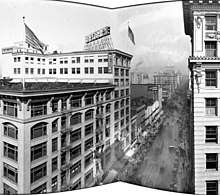
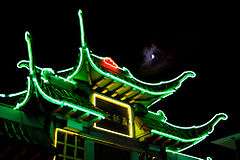
.jpg)
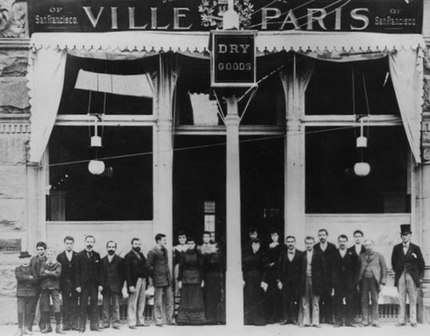
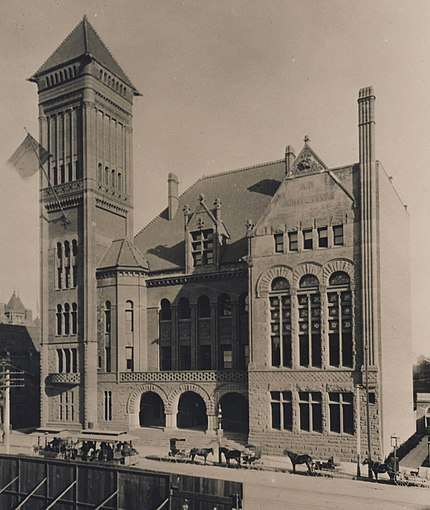
.png)

_on_the_corner_of_Eighth_Street_and_Broadway%2C_Los_Angeles%2C_ca.1912_(CHS-5541).jpg)
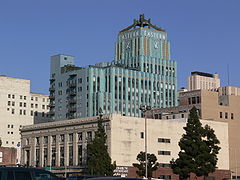
_LC-HS503-453.jpg)

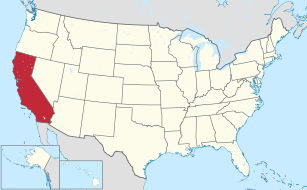
_edit1.jpg)